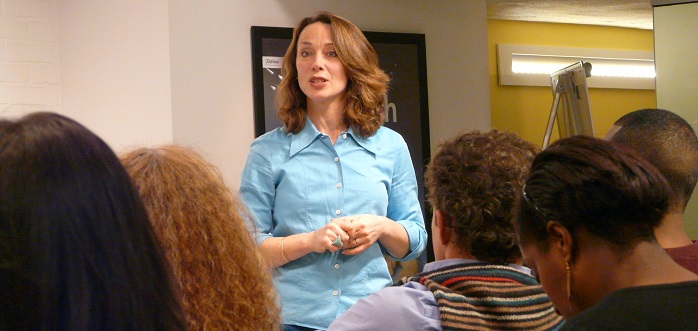Amanda Ruiz, PR coach and consultant answers your questions
Last week Amanda Ruiz, PR coach and consultant led an insightful webinar discussion about how to get creative when it comes to thinking of press hooks. From learning how to find the right journalists for your audience, getting journalists to respond to your emails, calls, and tweets to getting the right angle for your story, our webinar covered it all. Having created The 7 Secrets on How to Get into the Press and with over 25 years of experience in the PR and marketing, Amanda gave expert advice during the webinar on how to fine-tune your approach and maximise the value of your PR. As the webinar generated lots of conversation online, Amanda has returned to the Vuelio platform to answer your questions.
When pitching to a journalist, would you send the full article and images with the email, or simply send an overview of your idea? Journalists are very rushed for time so I would recommend not giving a ‘teaser’ or overview but a short and snappy email with concise bullet points backed up with statistics (if available). You also need to consider your email subject line, which must capture their attention and not be ‘vanilla’. Take a look at this blog post I wrote on how to get an awesome headline. Also, do not send high-resolution images as this will clog up their inboxes and they are unlikely to click on them.
If you can send your press release (ie the bullet points and brief intro on your idea) along with an image or two in the body of the email (not as an attachment), this would be the best option. I have a very successful press release template which gives you the layout and format for you to create your own press release.
Do you tend to be more successful with email pitches or cold calling? Whilst journalists will tell you to NOT call them as they are on deadline and don’t want to be swamped with calls, I personally have found the call followed by sending the press release to be the most effective. Don’t forget you will have to be short and sweet on the phone, and try to ‘Nail it in 8’, do an eight word elevator pitch/biography before you talk about your topic. Read my post about how to pique your target’s attention without letting their eyes glaze over!
Do you have any specific advice for a B2B medical business? I would recommend you get to know the client avatars of the company you are representing, and by doing this exercise, you will get to know your target audience much better and discover which publications they read and therefore the ones you should be approaching. Keep up to date with the press and be ready to react to a story that is current. How about doing a survey with your medical findings? Surveys are in the press daily and this is an excellent way to get coverage.
How do you appeal to bloggers and tap into the influence they have? Bloggers and Vloggers tend to do reviews in exchange for payment or free samples, so be prepared to set up a ‘Bloggger’s Budget’ if you want to go down that route. Otherwise, try to be creative and get to know how they talk and write, what they write about and try to make your pitch resonate with how they are as people. Try to be as human as possible – ie appeal to the human connection you may have with them. For example, are they from your home town? Did you go to the same school? Do you have the same outlandish hobby?! You never know! See if you have things in common – and bear in mind they are approached daily – rather like journalists, so think about approaching them in the same concise yet eye-catching manner possible.
Could you advise us about successful subject line words like ‘exclusive’ that provoke action? I love writing subject lines – I was advised by a prominent journalist that they don’t like ‘jazz hands’ nor do they like you to do the headline writer’s job by being too clever. If you want to use ‘Exclusive’ make sure it is exclusive to that publication, and follow it up with them personally to see if they will be using the story. If they aren’t going to use the story, then you can go to the next best target and do the same until someone bites!. Another thing that always captures journalists’ attention are the stats, eg 95% of women don’t do xyz….! Then talk about this very stat in the body of the email so you are consistent with the headline. I mentioned this controversial headline on the webinar I recently wrote for a client: “Finally you can LOVE having your period”. It got lots of call outs for samples and high-resolution images but one person got in touch to say she thought the headline was over the top and who could ever love having their period? When you raise your head above the parapet, be prepared to get shot down, and if you are, it means you have caused a stir!
Do you have advice for PRs with no budget who want more visibility? I launched my knitwear label with zero budget yet I managed to get into Vogue, Marie Claire, Woman and Home, The Telegraph, The Sunday Times. This is why I am passionate about teaching as many people as possible how to get publicity for free and to not spend a penny on advertising.
How do you use your ideas to persuade senior colleagues who are afraid to issue light-hearted press releases and ideas? I think that’s a matter of confidence as well as testing. So firstly, have the confidence to believe in your release, so write it, and then present it to the senior colleagues. Then, you can test it against the serious press release. The one that gets the best results for that specific story will win the day. My preference, as you may have gathered, is for the more light-hearted approach, but it really does depend on your industry. Even light-hearted press releases can have lots of ‘sexy stats’ the journalists can’t ignore, so when you pitch it to the colleagues, show them your statistics which will give weight to the release. Just think back to the “Finally you can LOVE…” press release!
How do you get the balance right between being persistent and over-contacting? Great question – if your release instantly stands out from the crowd and they are interested in it, then you should get a reply in the hours or day after you send it. If not, wait three days, then you can call the journalist up but never ask: “Did you get my press release?”. This is a journalist’s pet hate. Firstly, do a bit of twitter ‘stalking’ – see what they are talking about, read their articles that they will have shared online and try to ‘get to know’ the journalist before you speak to them. When you do call up, do your short and snappy 8-word intro, then lead on very briefly about the angle or the press hook. They may say, sorry, we are not the right publication or that’s interesting, please send me a press release. So send off the release and wait patiently. If they are interested, you will be contacted within three days. The golden rule according to my journalist source, is if you send out a press release to the same person three times (over a period of time) and you haven’t received a response, then you will not get a response. Try to change up the title and your target journalist, then start the process again. Please bear in mind that you don’t want to get black listed like I was when I was promoting my knitwear brand – I didn’t have a PR Plan of Action and I called the same poor journalist three times (by accident as I wasn’t taking proper call notes) and on the third time she asked me to never contact her again!! I think enough water is under the bridge now that I can approach her again if only I could remember her name!
What would be the best time to send a story to a journalist in your opinion? It really does depend on which publication you are trying to get in contact with. For the Sunday papers, I was told by the correspondent there that Tuesday is a good day. For the dailies – that really does depend on which publication and time-wise, that also depends. Some journalists like to go through their in boxes in the evening, others will reply instantly, so there isn’t the perfect time. So my advice would be, call up the journalist and say that you are looking to share a story, when would be the best time to get in touch via email or phone? And by saying ‘email’ they can’t rebuff you and say, “Don’t call me!” as you have given the option to be able to send an email (which is mostly their preference). Be prepared for them to ask you what the story is about, so by simply doing your research call, you may have turned that into a Pitch to the Journalist call! Which also means, have your press release and statistics up your sleeve to crib off when speaking and to email once the phone is down. This approach should ingratiate yourself with the journalist as it shows you are not treating them like a number, but a human!
As a thank you for registering for the webinar, go here to download your free ‘Digging for Golden Nuggets’ worksheet






Leave a Comment